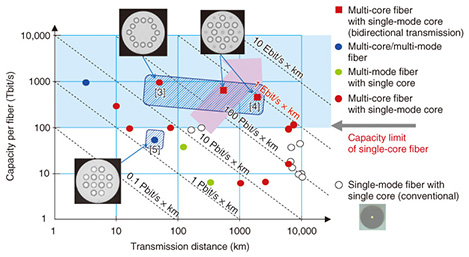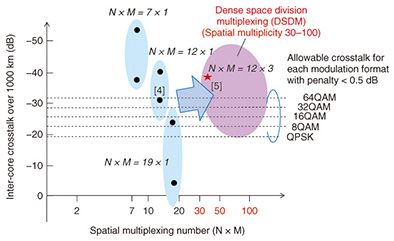 |
|||||||||||||||||||
|
|
|||||||||||||||||||
|
Regular Articles Vol. 12, No. 12, pp. 43–49, Dec. 2014. https://doi.org/10.53829/ntr201412ra3 Dense Space-division-multiplexing Optical Communications Technology for Petabit-per-second Class TransmissionAbstractResearch and development (R&D) of space division multiplexing (SDM) optical communications technology is well underway at NTT toward achieving high-capacity transmission on the order of one petabit (Pbit) per second or higher, which is equivalent to 100–1000 times the capacity of existing optical fiber. In this article, we describe the current state and future outlook of our R&D efforts in dense SDM. With this technology, we aim to achieve a quantum leap in optical network capacity through the use of multi-core fiber containing multiple optical-signal pathways in a single fiber and a multi-mode fiber capable of mode-division multiplexing. Keywords: space division multiplexing, large-capacity optical network, multi-core/multi-mode optical fiber 1. IntroductionThe history of optical communications technology driving the increasing capacity in optical networks is shown in Fig. 1. Up to now, the fundamental transmission medium in the optical network has been single-mode optical fiber designed with only one optical pathway (core) per fiber and one waveguide mode. NTT laboratories have contributed to increasing the capacity by nearly five orders of magnitude over the last 30 years by researching, developing, and commercializing economical cutting-edge optical transmission systems that maximize the broadband characteristics of this single-mode optical fiber. In the 1980s, the capacities of the Gbit/s class were first achieved with electrical multiplexing technology that enabled high-speed modulation of a single wavelength. With this technology, NTT constructed a reliable and economical core network for telephone communications. Then, in the mid-1990s, the need arose for an optical network that could economically transfer the large volumes of data traffic brought on by the spread of the Internet, and the development of optical amplification technology and wavelength multiplexing/demultiplexing technology enabled the deployment of wavelength division multiplexing (WDM) systems for simultaneously transmitting multiple wavelengths. Then, as the performance of WDM filters improved through the use of silica-based planar lightwave circuits, and the number of wavelength-multiplexed channels came to exceed 30, dense wavelength multiplexing systems became a reality.
At present, a dense wavelength-multiplexing, optical-amplification system having a transmission capacity of about 1 Tbit/s (= 1000 Gbit/s) using a single-core fiber is being put to practical use. In addition, recent advances in large-scale, ultra-high-speed CMOS (complementary metal oxide semiconductor) integrated circuits have focused attention on digital coherent technology that can achieve high-sensitivity coherent detection using ultra-high-speed digital signal processing at speeds above 100 Gbit/s per channel. There is much research and development (R&D) activity at present centered on the deployment of practical communication technologies and the improvement of transmission performance. Digital coherent technology improves receiver sensitivity and spectral efficiency while also significantly improving dispersion-compensation performance before and after long-distance transmissions. At present, large-capacity transmission of the 100-Gbit/s-per-wavelength class is being achieved through polarization division multiplexing that modulates separate optical signals along different polarization axes in the optical fiber through QPSK (quadrature phase shift keying). With this technology, a high-capacity optical network of the 10 Tbit/s class using existing optical fiber would be practical for a carrier frequency spacing of 50 GHz as used in conventional WDM systems. At the research level, 100 Tbit/s large-capacity transmission has been reported by using higher-order quadrature amplitude modulation (QAM) such as 64QAM and 128QAM. However, when capacity is increased in excess of 100 Tbit/s, various limitations begin to appear in the optical transmission medium and transmission system. Against this background, space division multiplexing (SDM) has been proposed as a high-capacity optical transmission technology that can overcome the physical limitations of conventional single-mode optical fiber by adding a spatial degree of freedom to the optical-fiber medium and enhancing the level of digital signal processing [1]. The R&D of SDM has been quite active in recent years. The Innovative Photonic Network Center at NTT Network Innovation Laboratories is engaged in R&D of innovative fundamental technologies for the future that can raise the density of SDM technology and enable the deployment of a long-term, scalable optical network with transmission capacities of the 1 Pbit/s (= 1000 Tbit/s) class, surmounting the 100 Tbit/s level. These technologies will be achieved by bringing together NTT proprietary system technologies, key products, and materials technologies and by establishing extensive collaborative relationships and technology tie-ups both inside and outside NTT laboratories. In this article, we introduce the state of our R&D efforts in dense SDM technology as one of these fundamental technologies for achieving a scalable optical network that can extend transmission capacity in a sustainable manner into the future. 2. Technical issues with optical communications systems using single-mode optical fiber2.1 Limited spectral efficiencyThe first issue in conventional optical transmission technology is a limit to the spectral efficiency due to nonlinear optical effects*1 in the optical fiber. Traditional communication theory states that the upper limit of spectral efficiency (communication capacity per band) with respect to a fixed signal-to-noise ratio (SNR) is given by the theoretical Shannon limit*2. In an optical-fiber communications system, however, increasing the signal power to proportionally increase the communication capacity generates crosstalk (leaking of optical signals) between WDM signals and distorts waveforms because of nonlinear optical effects in the optical fiber, thereby preventing the long-distance transmission of signals. These nonlinear optical effects in such an optical-fiber communications system further limits the spectral efficiency beyond the value given by the Shannon limit. In recent years, WDM systems have come to apply high-performance error correction techniques that enable the transmission signal power to be designed at a level in which nonlinear effects do not dominate, and high-capacity systems have been achieved in this way. Recent studies have also focused on techniques that use digital signal processing to compensate for the impairment in signals caused by these nonlinear optical effects. Furthermore, in the case of submarine transmission systems, a certain degree of freedom is given in newly designed optical fiber, so optical fiber that reduces nonlinear optical effects by increasing the core diameter have come to be applied. Steady progress can be expected in design technologies for long-distance, large-capacity systems that combine the above elemental technologies to suppress nonlinear optical effects and improve spectral efficiency. Nevertheless, to improve system gain by more than one order of magnitude over the long term, that is, to achieve a dramatic leap in transmission-performance scalability beyond 100 Tbit/s, there is a need for new technology that can surmount the physical limit in spectral efficiency that is characteristic of single-mode optical fiber. 2.2 Limited optical input powerThe second issue is optical input power limits due to the damage threshold of optical fiber. In the actual deployment of WDM optical-amplification-repeater systems, high-power input is becoming the norm in optical fibers making up the optical communications system, and at present, the optical signal power is typically on the order of 100 mW (1 mW per wavelength). To raise transmission capacity even further, signal input power in fibers will, in essence, have to be raised, which means that the power output from optical amplifiers will have to be increased above present levels, and the allowable incident power in optical fibers will have to be taken into account. As a physical limit, consideration will have to be given to the fiber-fuse thermal-breakdown phenomenon in optical fibers. This phenomenon can occur while an optical signal is propagating through an optical fiber’s core that is approximately 10 μm in diameter. At this time, if local loss and optical absorption should occur at some location in the core for some reason, the temperature of that core section can suddenly rise, causing the core to fuse together and forcing the damaged portion to propagate back toward the optical source. The threshold for stopping fiber-fuse signal propagation in existing optical fiber is being studied in detail, but it is currently known to be in the range of 1.2–1.4 W. To prevent this phenomenon from occurring, operation technologies and safety guidelines that provide for safe handling of high-power signals in the field have been established. As a result of these efforts, safe operations have been achieved in actual commercial systems. Accordingly, with an eye to further increases in capacity, we will need to research and develop optical fiber, optical connector, and optical communication system technologies with high power-resistance qualities and a high level of safety for telecom operators to avoid this fiber-fuse limitation.
3. Overview of SDM optical communications technologyTo overcome the two problems described above, we propose an SDM optical communications system as shown in Fig. 2 that maximizes the use of the optical fiber’s spatial degree of freedom and that increases the cross-sectional area of the core to expand transmission capacity without increasing the power density of the optical signal. This system can be divided into two types as described below [2].
3.1 SDM transmission system using multi-core fiberThe advantage of an SDM optical communications system using multi-core fiber (in which a single fiber is configured with multiple cores) is that the total transmission capacity per fiber can be expanded without increasing the power density per core. Here, optical-signal crosstalk between cores is the most important design consideration in a multi-core optical fiber communications system that aims to ensure the independence of each core. With a multi-core optical fiber communications system consisting of single-mode cores as used in conventional optical fiber, appropriately designing the arrangement of cores taking inter-core crosstalk into account makes it possible to increase the system capacity by increasing the number of cores with just one fiber. This type of system can also use the same type of optical transmitters and receivers as that in conventional single-mode optical fiber systems. 3.2 SDM optical communications system using multi-mode fiberThis type of SDM system uses multi-mode fiber that expands the effective area of the core and decreases power density. An inevitable result of expanding the effective area of the core is multi-mode optical fiber having a number of waveguide modes, in each of which a signal can propagate. In past optical communications systems, it was difficult to achieve multiplexed transmission by having the same wavelength (optical carrier frequency) carry individual signals in different modes. This is because it was technically difficult on the receiver side to separate those individual signals transmitted in different modes. However, it has been shown that mode separation on the receiver side can be facilitated by equipping the optical communications system with transmitter/receiver digital signal processing that employs multiple-input multiple-output (MIMO)*3 signal processing developed recently for mobile phones and wireless LAN (local area network) systems. As a result, mode-division-multiplexing optical communications systems that can increase the spatial multiplexing number by increasing the number of allowed modes are now being intensively studied. The number of modes that can be separated is essentially determined by the amount of delay between modes and the feasibility of digital signal processing. Presently, at the research level, there have been reports of multiplexing/demultiplexing transmission experiments of up to six modes excluding polarization modes performed by experimental (offline) digital signal processing using memory storage and computers. The above SDM optical communications systems using either multi-core fiber or multi-mode fiber are independent technologies. Combining them in an appropriate manner opens up the possibility of achieving a dense SDM optical communications system having a spatial-multiplexing number greater than the 30–100 in WDM systems.
4. SDM optical transmission experiments and future outlookAs mentioned above, the R&D of SDM-based communications has been quite active in recent years, and at the research level, experiments are showing that SDM can achieve values for loss, dispersion, and other properties at nearly the same level as that of conventional single-mode fiber. Device technology is also progressing in relation to using the interface technology (fan-in/fan-out devices, fusion techniques) of conventional single-mode optical fiber with multi-core optical fiber, and a number of high-capacity transmission experiments and long-distance transmission experiments using multi-core fiber have been reported. The current state of R&D efforts in SDM is shown in Fig. 3. Recent achievements in top-class transmission capacities correspond to transmission experiments using multi-core fiber. Under partial support provided by the National Institute of Information and Communications Technology (NICT) in the form of commissioned research and through collaboration with other research institutions, NTT laboratories and their research partners have achieved the cutting-edge results shown in the shaded area in Fig. 3 [3–5]. Specifically, we were the first in the world to perform a successful high-capacity transmission experiment above 1 Pbit/s in September 2012 [3] and a successful long-distance transmission experiment of the Pbit/s class in September 2013 [4] by combining single-mode/12-core multi-core fiber with multi-level modulation/demodulation technology such as 16QAM and 32QAM that can enhance the spectral efficiency per core.
To increase the multiplexing number (number of cores) while maintaining signal independence between cores, it is essential that inter-core crosstalk be suppressed to some extent. This requirement calls for core-arrangement design that can increase the number of cores while preserving a core interval greater than a prescribed distance. At the same time, careful consideration must be given to the upper limit (about 200 μm) of the cladding diameter in a multi-core optical fiber from the viewpoint of ensuring mechanical reliability, so a trade-off exists that prevents the number of cores from being infinitely increased. The relationship between crosstalk over 1000 km and the spatial multiplexing number is shown in Fig. 4 in relation to large-capacity transmission experiments using multi-core SDM transmission. Multi-core/single-mode fiber transmissions with a core number N of 7–19 have been reported to date, but since crosstalk can increase as the number of cores is increased within the cladding diameter limit, the spatial multiplexing number is limited at 19 under these conditions. In this regard, considering the future progress of higher-order QAM digital coherent transmission technology, we can consider the application of multi-level modulation systems above a level of four (8–64QAM). It is therefore thought that allowable crosstalk between cores should be under –30 dB after transmission.
Furthermore, in terms of optical fiber for infrastructure use, it would be desirable to ensure scalability in the degree of multiplexing over several decades, as in the case of single-core fiber. In March 2014, in collaboration with research institutions both inside and outside NTT, the Innovative Photonic Network Center at NTT Network Innovation Laboratories performed the world’s first successful ultra-dense SDM transmission experiment exceeding a spatial multiplexing number of 30 using 12-core multi-core/multi-mode fiber and achieving 3-mode multiplexing/demultiplexing in each core (spatial multiplexing number of 36 = 3 modes × 12 cores) [5, 6]. Looking to the future, we can expect further progress to be made in lengthening the transmission distance of ultra-dense SDM communications using multi-core/multi-mode fiber that can extend the scalability of the multiplexing number beyond 30–100 while suppressing inter-core crosstalk. References
|
|||||||||||||||||||














